
Published: January, 1963
Script: Stan Lee
Pencils: Jack Kirby
Inks: Dick Ayers
Letters: Art Simek
Now that I’ve gone through a number of origin stories, as well as the introduction of many major characters, I may slow down the pace. I don’t have the time (or the energy!) to write a lengthy review of every single Marvel comic ever published. The purpose of this blog is to hit the high points. If there are some points that don’t reach as high as others, but you’re still interested in seeing what’s going on in the Marvel Universe, you can always visit my “Meanwhile…” posts to view the titles and covers.
For instance, just before FF #10, in Journey Into Mystery #87, Thor fights the Commies. You know how I feel about Commies. Ho hum… There are a few cute moments with Jane Foster, but not enough to warrant an entire blog entry. So I’m skipping that one.
THE TRIPLE WHAMMY
But this one. FF#10….this one I’m NOT skipping! No way, brother! I took a look at the cover and right away I knew this one was a keeper, and worthy of any number of words I might devote to it. What a trip! This has got to be one my favorite FF stories so far!
And why? Well, on the cover, we see Stan and Jack, and we’re told that we will get to meet them inside! I mean…c’mon! How much fun is that? And not only that, but on the cover we also learn that Doctor Doom is going to be one of the FF and Reed will be the villain. Oh! And in case all of this is not compelling enough, we’re also promised “a gorgeous pin-up of the Invisible Girl.”
It’s a triple whammy! If you aren’t intrigued enough by the prospect of seeing the creators in their own story, then surely you wonder how it is that Mr. Fantastic will be a villain. And if none of that really interests you, then maybe you’re titillated by the idea of the “gorgeous pin-up of the Invisible Girl.”
What most piques my interest is the prospect of seeing Stan and Jack in their own story. Yeah, I’ve got to admit, I’ve always been an aficionado of the deconstruction of the “Fourth Wall.” I think it started many years ago, when, as a wee one, I saw a televised presentation of the stage play where Mary Martin portrays Peter Pan. Not only was I fascinated by the idea of a grown woman playing a little boy, but I especially enjoyed that moment when the audience is encouraged to assist in Tinkerbell’s recovery by earnestly reciting, “I DO believe in fairies! I DO believe in fairies!”
Around the same time, there was a children’s show called Romper Room, where the lady running the show would look through a “Magic Mirror” and call out, “I see Bobby and Susie and Johnny and Mary…” I always hoped she would say my name, but in the early 1960’s, “Christine” was not en vogue, apparently, due to the recent association with infamous sex-change celebrity Christine Jorgensen. So I don’t think I ever actually heard my name called. Sigh…
But anyway, any time a show or movie or book becomes “self aware,” I’m almost always on board. For this reason, I’m enchanted by the children’s books, A Series of Unfortunate Events. And for this reason, though I’m not a tremendous fan of Ferris Bueller’s Day Off (the main character really grates on me), I do enjoy the way he talks to the audience. And no discussion of the Fourth Wall would be complete without a nod to this tremendously entertaining example from one of my very favorite shows, Northern Exposure (Season 2, War and Peace).
But I have digressed entirely too much! Let’s get back to Marvel Comics!
THE RETURN OF DOCTOR DOOM
We begin FF #10 hanging out with the FF, but the story doesn’t really kick in until we see Stan and Jack in their office, lamenting the loss of Doctor Doom in the coldness of outer space, because he’s the best villain of all…and then… surprise surprise! Doctor Doom shows up at their door!
Doom threatens Stan and Jack into setting up a meeting with Reed. (Apparently Stan, Jack and Reed get together frequently to hash out new FF plotlines.) When Reed arrives, Doom knocks him out with sleeping gas, then carries him off “by means of the mystic science known only to Dr. Doom!” He leaves Stan and Jack in charge of contacting the other three, anticipating they will surely race to Reed’s rescue.
And of course they do. But not before Doom explains to Reed how, at the end of their last adventure, he was picked up in space by the Ovoids, egghead aliens from whom he learned the skill of body switching.
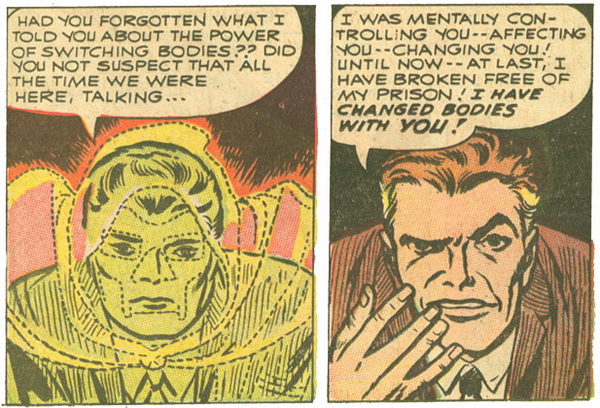
When the other three arrive, they attack “Doom” (who is really Reed), and “Reed” (who is really Doom) suggests throwing the “villain” down a secret hatch and imprisoning him in “a thick, unbreakable plexi-glass prison.” Thing is concerned “Doom” might run out of air (“We don’t wanna murder the creep!”), but “Reed” assures him there’s plenty of air in the dome. Of course, he’s lying. The plexi-glass prison only contains a one-hour supply of air!
Doom giddily ponders all the fantastic possibilities for evil he can achieve in his new guise as Mr. Fantastic, and quickly informs the others that he has perfected a “Reducing Ray” gun that can be used to increase their powers. His reasoning goes something like this (and I paraphrase):
The dinosaurs were too large and their brains were too small, therefore they became extinct. But if their bodies had been smaller, their brains would have been larger IN COMPARISON, and “today the dinosaurs might STILL be the rulers of Earth!”
Yeah, I know. It doesn’t really make sense, but the others buy it, no questions asked. Either they would never doubt anything Reed tells them, or perhaps they are simply so anxious for the described benefits—Torch can “Flame on!” for longer periods of time, Sue can control her invisibility, and Thing will be able to transform back to 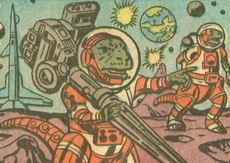 Ben Grimm whenever he wishes! Or so says Doom.
Ben Grimm whenever he wishes! Or so says Doom.
What he’s really up to, of course, is that he wants to hit them with the Reducing Ray gun so hard they disappear altogether. Then, with the FF out of the way, he can get on with his plans for “absolute dominion of all the earth!”
But there’s one thing Doom hasn’t counted on. There’s no thick, unbreakable plexi-glass prison built yet that can contain Reed Richards’ enormous intellect and resourcefulness! Reed breaks out of the prison and goes immediately to Alicia. You think for a moment he’ll be able to reason with her, because she can’t see that he looks like Doom. And she does, in fact, marvel that “There’s an aura of goodness about him—of nobility!”
But alas, Sue is there, and hits “Doom” over the head with a vase. Yes, a vase, and that knocks him out—I guess Doom’s armor isn’t all it’s cracked up to be. The others come in and take him back to FF HQ.
The character who looks like Doom keeps insisting he’s Reed, and in fact, Thing and Torch have been wondering what’s been buggin’ them about this guy, so they devise a test. Torch warms 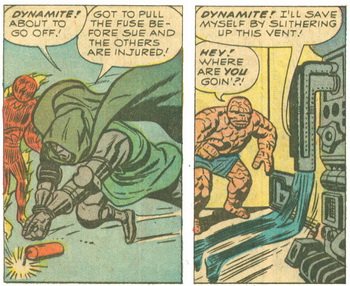 up the particles in the air to create a “heat mirage” in which a stick of dynamite seems to appear in the room. Sensing danger, “Doom” falls on the dynamite to protect the others, while “Reed” slithers up the nearest pipe, lickety-split.
up the particles in the air to create a “heat mirage” in which a stick of dynamite seems to appear in the room. Sensing danger, “Doom” falls on the dynamite to protect the others, while “Reed” slithers up the nearest pipe, lickety-split.
Thing prevents Doom from escaping and “under the staggering shock of learning that his incredible scheme has been exposed,” the spell is broken. Desperate, Doom attacks with a sub-miniature transistor-powered atomic blast gun hidden in his index finger. The attack probably doesn’t last as long as it takes you to read the words “sub-miniature transistor-powered atomic blast gun.” The blast goes wild and activates the reducing ray gun…on DOOM! Our villain shrinks and shrinks until…poof! All gone.
And that is the end of our tale. But is it the end of Doctor Doom? Not so fast! Remember the old comic book adage: if you don’t see a body, they ain’t dead. And at the end of this story, there is no body. Doom has returned from certain doom once already, so I’m sure that somehow, someday, he’ll find his way back to us for further shenanigans with the Fantastic Four.
ART
While we wait for that to happen, I have a few observations about this story. First, you know, I usually spend a lot of time commending Stan on the fabulous job he does with these stories, but in this one, it’s Jack Kirby who shines. I so enjoyed his artistic interpretation of Doom inside Reed’s body.
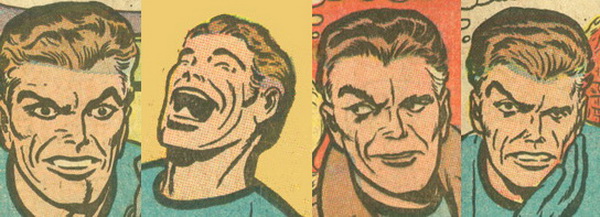
Some of these expressions were so intensely different than anything we would ever see from the real Reed Richards, that there could be no doubt who is in that body at the moment. Also, I got a big kick out of the way he portrayed himself and Stan, always showing them from behind, or in shadow, or with their faces hidden, so that even with the deconstruction of the Fourth Wall, a good deal of mystery still remains about the creators.
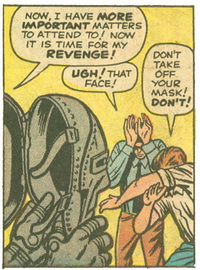 I’m kind of disappointed that Lee and Kirby don’t make an encore appearance later in the story. And I wonder if they’ll make future appearances in other comic mags. To do something like this never occurred to me, it took me totally by surprise and I was absolutely delighted by the trick.
I’m kind of disappointed that Lee and Kirby don’t make an encore appearance later in the story. And I wonder if they’ll make future appearances in other comic mags. To do something like this never occurred to me, it took me totally by surprise and I was absolutely delighted by the trick.
FANS
But I guess I really shouldn’t have been that surprised. After all, we know from past comics that Stan is no stranger to tooting his own horn, and engaging in blatant self-promotion. Yet he always does it in such a way that you have to chuckle. Putting himself and Kirby into the action also gave us the opportunity to see an overflowing stack of fan mail in their office.
 And at one point, the FF are just trying to move about the city when they get swamped by adoring fans. Sue has to evade a lecherous flirt by going invisible (“Get lost, repulsive!”) and Mr. Fantastic uses his amazing ability to slink away from a mob of over-excited admirers. I guess by this time everyone has completely forgotten what happened in the last issue, when the crowds engaged in classic “Kick ‘em when they’re down!” behavior. No more raised fists, now it’s all “Come here, you adorable thing!”
And at one point, the FF are just trying to move about the city when they get swamped by adoring fans. Sue has to evade a lecherous flirt by going invisible (“Get lost, repulsive!”) and Mr. Fantastic uses his amazing ability to slink away from a mob of over-excited admirers. I guess by this time everyone has completely forgotten what happened in the last issue, when the crowds engaged in classic “Kick ‘em when they’re down!” behavior. No more raised fists, now it’s all “Come here, you adorable thing!”
ROMANCE
That’s “thing,” with a lower case T. But when we talk about Thing with an upper case T, we find that Alicia, step-daughter of the Puppet Master, is now referred to as Thing’s “girlfriend.” What a sweet story, and how perfectly they balance each other! She’s all alone in the world, and needs someone big and strong to protect her. And Thing really needs a calming influence in his life, don’t you think?
We also learn that Alicia has taken up her step-father’s hobby, and has sculpted representations of all the villains the FF have fought thus far. How does she know what they look like? I guess Thing described them to her in detail. I can see them sitting together of an evening, Alicia whittling away as Thing waxes eloquent on the details of every scoundrel that ever dared to cross his path.

Of course, Sue takes exception to Namor’s inclusion in this group of “horrible menaces.” At which point, Reed, ever the sensitive and romantic boyfriend (NOT), suddenly decides to engage her in a heart-to-heart about their “understanding.” He chooses to discuss their very private matter, right there in front of all their friends.
But Sue doesn’t want to talk with him about it—“Not now! Not yet!”—not so much because she’s concerned with the lack of privacy, but moreso because she is still not sure of her own feelings for Namor.
I like the way they leave this storyline open for further soap opera developments. That’s why I’m here! Sure, I’m starting to feel more invested in the villains, and the classic battles of good and evil, but at the end of the day, every girl wants a love story.
PIN-UP
The “pin-up” of the Invisible Girl appears at the end of Part 1, and no, she is not invisible, she’s standing in the Fantasti-Car, fully clothed in her uniform, not wearing a bikini at the beach. So it’s not really much of a “pin-up,” just a one-page break in the story for Sue to say, “Love and Kisses to my Wonderful Fans.”
When I read on the cover that there was a pin-up of the INVISIBLE Girl inside, of course it occurred to me that this could be some kind of joke, all scenery and no girl. But Stan and Jack did not go there.
However, they did go here: in the upper right-hand corner, there’s a note from the editor, instructing the reader to notice the control panel of the Fantasti-Car. These details are provided in response to “many requests.” So, it seems that in late 1962, we still had a very young audience, if they are looking right past Sue’s fabulous form to the gadgets on the dashboard. I know eventually Marvel will improve the artistic depiction of female characters, and dress them in more revealing outfits. But it’s the early 60’s, a simpler and more innocent age, and we are not there yet. Not by a long shot.
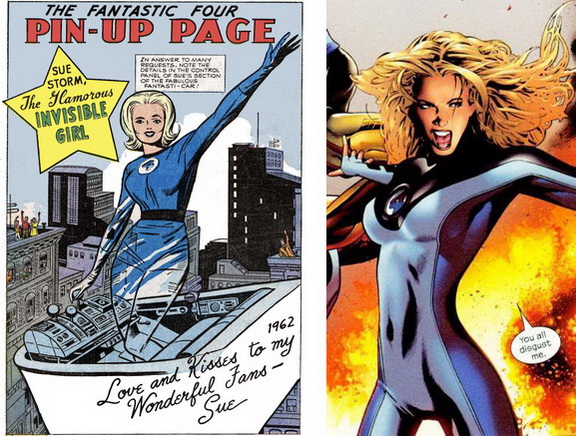
BODY SWAPPING
In Journey Into Mystery #86, I learned that Thor has the ability to travel through time, and observed that this would open up all kinds of story possibilities. Now, I’m learning that Doctor Doom can “body swap.” This is a skill he learned from the Ovoids, not reliant upon a magical amulet that might get broken or stolen, so it’s reasonable to assume that when Doom returns, he will still possess this skill. And if in fact he does….whew! What a tremendous number of story possibilities this opens up! Almost, one would think, to the point of being unmanageable.
Having the body-swapped dilemma in one story is entertaining, but if Doom can body swap in every story, it will cause so much confusion for the heroes, but even more confusion for the readers, that eventually, I imagine, we would all just lose interest. So I’m guessing that future stories may simply “forget” Doom’s ability to body swap, or perhaps the FF will come up with counteractive strategies. In the same way that I look forward to finding out if Thor will once again use his time-traveling abilities, I also look forward to seeing how body-swapping will be handled in future stories with Doctor Doom.
WORLD WITHIN A WORLD
I’ve gotten to a point in my reading of Marvel Comics that I feel there are so many things that can be predicted, but at the same time, there is much I could never even begin to guess at. That makes my Adventures in the Marvelous Zone both comfortable and exciting, at the same time.
As for FF #10, when I’ve said everything I have to say, it’s still always going to come back to the anomaly of seeing the creators in their own story. It baffles me, it flabbergasts me, it intrigues me and delights me. I’m trying to wrap my mind around the relationships between the FF as we see them in the comic stories we are reading and the real FF, the group of superheroes who confer with, as Thing refers to them, “those two goons who write about us.” Where does reality leave off and fiction begin? Of course it’s all fiction, but within the fiction, there’s a premise of reality I need to make sense of.
I’ve discussed this with Russ at length and here’s the way I understand it: within the reality of the Marvel Universe, there is a group of superheroes called the Fantastic Four, who live in the very real Baxter Building in the very real New York City, and they fight crime. They are public figures within their own society.
At the same time, because they are so public, there are these “two goons,” Stan Lee and Jack Kirby, who have undertaken to provide “comic mag” stories about them. The content of these stories are purely fictional.
To some degree, these “comic mags,” (the newsprint items bought at the drug store or newsstand for 12 cents) are somewhat like “Fan Fiction,” in that they are fictional stories. But Fan Fiction is fiction ABOUT fiction. These stories are fiction about “real” people.
Okay. Think of it this way: Everybody loves Bella and Edward and Jacob, and I’m sure there are thousands of Fan Fictions written about these characters. But if someone were to write fiction about Kristen Stewart and Robert Pattison and Taylor Lauter, THAT would be the equivalent of the 12-cent comic mag Stan and Jack are producing about the FF. (Which, by the way, if you know anything about Fan Fiction, this is strongly frowned upon.)
Of course, it’s not really the same, because the “fictional” Marvel Comics is licensing the adventures from the Fantastic Four, so presumably in this case, the Fantastic Four isn’t really frowning. But then, we saw in an earlier issue of FF that this fictional Marvel is also publishing a Hulk comic. Am I supposed to believe that Hulk has licensed his adventures to Stan and Jack? I don’t think so. He’s probably frowning upon it.
Maybe a better example would be…and I don’t know if this exists…but let’s say…JFK, when he was in the Navy, was in real life, a war hero, and now here comes somebody creating a comic book about some adventures that might have happened to him when he was in the Navy. Not a recounting of biographical events, but some made-up stories of things that might have happened.
Or, let’s try again…
When I was a teenybopper, one of my favorite celebrities was Bobby Sherman, from Here Come the Brides. In 6th grade, my autograph book was full of little poems like “If Bobby Sherman lived across the sea, what a good swimmer Christine would be!” One of my favorite magazines at the time, 16 Magazine, featured a fictional story about a fictional girl named “CeeCee,” who goes to the very real Hollywood and meets the very real actor/singer, Bobby Sherman. Is it kind of like that?
I don’t know if I can come up with any other examples of what this might be like, because I just don’t think in the real world (our real world), we create entertainment like that. So I’m grasping at straws here, trying to find a real life equivalent to explain the weird appearance of Stan and Jack inside their own comic.
You know, I think I’ll be pondering this one for a while. But I’ll put out this challenge: if anyone can think of an example of a current entertainment that correlates to Marvel’s unique and marvelous practice of writing fictional stories about “real” public figures (who, by the way, are actually fictional)…please let me know! I’m still trying to figure this one out!
![]() Our next stop in the Marvelous Zone doesn’t contain quite so many conundrums. Next time, it’s me hero, you villain, fight fight, win win! Where black is black, and white is white, and green is green. See you next week!
Our next stop in the Marvelous Zone doesn’t contain quite so many conundrums. Next time, it’s me hero, you villain, fight fight, win win! Where black is black, and white is white, and green is green. See you next week!
| Want to read this comic on your computer? Marvel has a scan! Want to own this story? Buy the Masterworks! |















Love the Jack Kirby/Greg Land pin-up juxtaposition.
At some point it’s said that the “Marvel comics in the Marvel Universe” depict dumbed-down or embellished versions of the various heroes’ actual adventures. So it’s kind of like historical fiction, like Gore Vidal’s Burr and Lincoln, where it’s based on true events but embellished. Except the comics are about current events instead of historical events. They don’t quite count as news (since they are embellished and the super-heroes apparently get veto rights) but it’s somewhere between that and true fiction.
Based on what you wrote it sounds like in this issue the comics are said to be pure fiction; i’m not sure when the “revelation” i’m talking about is introduced.
I’m assuming you don’t want any spoilers, like regarding Doom’s mind transfer powers, so i’m keeping mum.
I like that your description of “Marvel comics in the Marvel Universe” contains phrases like “they don’t quite count,” “somewhere between,” “it’s kind of like,” “but” and “except.” It’s really difficult to describe exactly how this all works. But it is a fascinating concept.
And yes, thank you for not providing any spoilers. I know I’ve got a lot to look forward to as I continue to make my way through the Marvel Universe, and I’m looking forward to all the stops along the way.
As far as I can see, the solution to the “is it real” question is clear.. but will not be popular with some other fans. 🙂
At the end of issue 9, Stan wrote the secret to his success: “incredible exploits and down to earth realism”. That is the key: realism. In numerous interviews he and others have said that realism is what sets these stories apart from other comics. Part of that realism is they take place IN THE REAL WORLD. Very issue (until issue 322 in 1989) has plausible deniability built in. That is, if you look carefully, no matter how gigantic the events, you could live in New York and think they really happened, but you were just unlucky not to be on the right street on that day. You can believe in these stories completely, and yet they push fantasy and science fiction to the limits. That’s what makes them so good!
SPOILER ALERT: in future issues it’s shown that the FF report to Marvel, and Marvel will not make anything up about them. However, Marvel does embellish the stories for dramatic effect. The clearest example of this is in Assistant Editors Month in the mid 1980s, in the FF and the Thing’s own title, but it’s also referenced at other places (most famously in the visit to the Marvel offices in FF176). Ben sometimes grumbles that Marvel don’t get it right all the time, but the understanding is that these events are real.
This leads to why other comic fans may not like it: the implication is that other comics are NOT real.
Certainly Spider-man doesn’t say “this is my secret identity and these are my personal problems, now go and print them!” Also, as many critics have noted, it is impossible for large numbers of superheroes to exist in the real world without the world being changed. besides, the whole concept of secret identities and brightly coloured skin tight costumes stretches belief – how would that possibly work in the real world? I’m so glad the FF have sensible uniforms and a business-like approach to their work. 🙂 But if we restrict the superheroes to just those we see in the FF title, with only the powers they display (generally far less than we see in their own titles) then it’s believable again. So, for example, there is a guy called Spider-man, but he’s very low profile, his powers are very limited, and Marvel doesn’t know much about him, so they just make up stories. Pretty much all the other stories are made up.
But this really shouldn’t bother other readers too much. As you have shown, you can get plenty of enjoyment by assuming these things are not real: it doesn’t bother most readers. But for me, believing the FF might be real makes them more exciting, and holds them to higher standard. I can expect FF stories to make sense to the smallest detail (allowing of course for Marvel’s exaggerations and times when Reed does not tell them the whole story). This means the FF stories work as a single gigantic story, no suspension of disbelief and no “it’s only comics.” That was the inspiration for my own web site: I think the FF is a far biger and stronger story than most people realise. But the rest of the titles? They’re just comics. 🙂 🙂
(Having said all that, I’d love it if somebody could come up with a way that the X-men or Avengers could be real, but I don’t know how they’d do it.)
Back in 2000, Marvel published a series of comics called the “Marvels Comics Group,” the premise of which was that these were copies of the comics as they appeared in the Marvel Universe itself, where the FF was “the only 100% authorized comic magazine.” Spider-Man was portrayed as some sort of sinister mystery-man because, hey, maybe the Daily Bugle is right and he is some kind of murdering menace. Captain America’s adventure was largely fictionalized because of government clearance issues so writer Rick Jones wrote a made-up time-travel story specifically for returning artist Steve Rogers to draw (Rogers drew the in-universe Marvel version of Cap back during the Gruenwald era), and Thor was a science-powered hero who only claimed to be a god because almost no one in the Marvel Universe REALLY believes in Asgard, Frost Giants, Fire Demons, and the like…
The experiment wasn’t very successful and the comics are rarely mentioned anymore. The Garth Ennis written “Codename: X-Men” was interesting in that it genuinely treats mutants and intellectually and morally inferior beings whose only wish is to die as humans and be free of the shame of their birth… An outrightly racist (or speciesist, if you prefer) book for an outrightly racist audience, presumably, since it is supposedly designed to sell within the Marvel Universe.
Overall, I was happier without the look “inside,” free to wonder exactly how Marvel did publish a Spider-Man comic without knowing he was Peter Parker. Still, as an exercise in playing with the Fourth Wall, these titles might be of interest to you.
Thanks, I had no idea! I applaud them for trying something interesting, but I agree that it creates as many problems as it solves. We all have our own approach to comics, and for me the strength of classic Marvel was that it supposedly takes place in our world. “Marvels Comics Group” sounds like an admission that they have abandoned that idea. Although, being obsessed with the FF, I very much like the idea that the FF stand out as the only real ones. 🙂